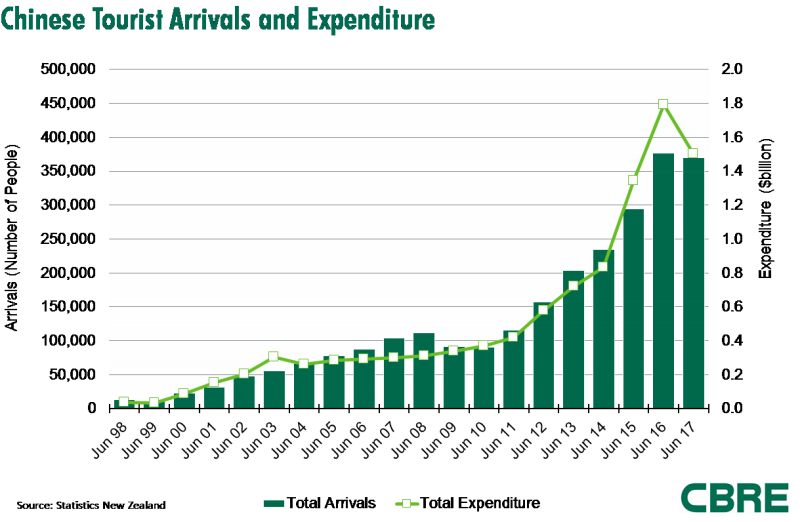Chinese tourists spending less on shopping, more on culture
Chinese tourists spending less on shopping and more on culture and experience
- Retailers and landlords urged to adapt to shift in tourist spending patterns -
Luxury shopping and package holidays are proving less popular with the Chinese tourist market compared to authentic food and entertainment experiences, according to new research by international real estate agency CBRE.
More than 135 million Chinese took overseas holidays in 2016 accounting for 11% of total international tourist traffic according to the report and of every US$5 spent by international tourists, US$1 is by Chinese travellers.
In New Zealand alone, Chinese tourists spent just over NZ$1.5 billion in the year to June 2017.
In recent years however, the Asia Pacific region report notes a major shift away from spending on luxury and other consumer goods towards culture and experience-based retail with significant implications for the retail sector.
It cites a survey from August this year in which just one-third of respondents selected shopping as their main motivation for travel, down from 68% in 2016 and another recent study which found spending by Chinese tourists on shopping has fallen by 40% between 2013 and 2017 while spending on food and entertainment has surged.
A more mature domestic retail market in China is a major reason for the trend according to the report with 54% of international retail brands having at least one store in tier 1 cities such as Shanghai as of the end of 2016.
E-commerce and ease at which Chinese consumers can shop for foreign-made goods is also seen to be having an impact while social media has played a part too by exposing tourists to a wider range of tourism experiences via posts and online reviews.
As a result, Chinese tourists are developing higher expectations and more discerning tastes when travelling aboard according to the report - looking for more experience based holidays focused on food, entertainment and local culture rather than package holidays with pre-planned visits to malls.

Tim Male, CBRE New Zealand’s National Director, Advisory & Transaction Services Retail says with China continuing to grow as one of our most important sources of inbound tourism it’s critical retail occupiers and landlords take note of the change in spending patterns.
“There’s plenty that can be done in this space so that occupiers and landlords stay relevant and continue to attract Chinese tourists. Providing an authentic local experience is a good place to start. This may be as simple as weaving in a New Zealand style into a fit out, or for shopping destinations it may be a case of incorporating local culture into their entertainment e.g. as food markets and concerts.”
Increased interest by Chinese tourists in local cuisine and dishes is another trend according to the report with data showing Chinese visitors to Australia spending a quarter of their budget on dining compared to an average of just 10% elsewhere in Asia Pacific. In New Zealand Chinese tourists’ spending on food and beverage has increased by 35% in the past year despite the slowdown in their overall spending.
Male says it’s no secret that food and beverage retail has been growing rapidly in recent years in the New Zealand market and with Chinese visitors increasingly spending a good chunk of their budget on dining it’s important operators capitalise on the opportunity.
“F & B retail that is unique in environment and/or product is the key to bringing in more tourist dollars.”
It’s not just food and local culture however, according to Male it’s also about offering of unique one-off products not available in China and refining retail service to ensure shopping can still be a part of a more active travel itinerary such as introducing click and collect services to increased presence at airports.
ENDS



 Hugh Grant: How Can Telehealth And Home Healthcare Solutions Be Helpful?
Hugh Grant: How Can Telehealth And Home Healthcare Solutions Be Helpful? New Zealand Merino Company: The New Zealand Merino Company Will Investigate PETA Claims
New Zealand Merino Company: The New Zealand Merino Company Will Investigate PETA Claims New Zealand Certified Builders: Building A Granny Flat? Four Things You Should Know
New Zealand Certified Builders: Building A Granny Flat? Four Things You Should Know Paul Scofield & George Young, The Conversation: The Discovery Of A Rare New Fossil Sheds Light On NZ’s Extinct Dolphin-like Reptiles
Paul Scofield & George Young, The Conversation: The Discovery Of A Rare New Fossil Sheds Light On NZ’s Extinct Dolphin-like Reptiles Spirits New Zealand: A Year Of Two Halves For The NZ Spirits Industry
Spirits New Zealand: A Year Of Two Halves For The NZ Spirits Industry MoneyHub: Comprehensive Guide To New Zealand Wage And Salary Distributions
MoneyHub: Comprehensive Guide To New Zealand Wage And Salary Distributions



